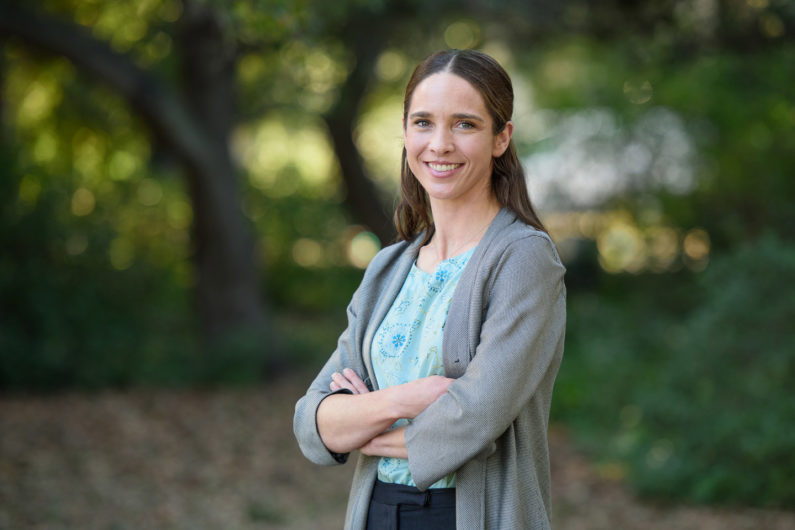Q&A with Katharine Mach: How can the world manage a historic climate agreement?
Stanford climate expert comments on opportunities and obstacles for advancing the Paris Agreement, an ambitious global climate pact that recently went into force.
Last week, the Paris Agreement, a global climate pact 23 years in the making, officially put into force unprecedented requirements for reducing emissions that fuel global climate change.

Stanford climate scientist Katharine Mach, who was involved with the Paris Agreement, describes the challenges facing the signatory nations now meeting in Morocco. (Image credit: L.A. Cicero)
Now, representatives of 196 countries are in Marrakesh, Morocco, through Nov. 18 to hash out details of managing the pact and ensuring all signatories meet the goals they committed to, not only cutting carbon output but also financing adaptation in developing countries and other objectives (Paris Agreement highlights).
Stanford climate scientist Katharine Mach, who helped inform some of the decisions that went into the Paris Agreement, talked with Stanford Report about opportunities and obstacles for the Marrakesh meeting, formally known as the 22nd gathering of the Conference of the Parties (COP22) to the U.N. Framework Convention on Climate Change. She joins Chris Field, the Perry L. McCarty Director of the Stanford Woods Institute for the Environment, as one of Stanford’s two official delegates to COP22. They and other Stanford experts have pioneered research needed to recognize and meet the challenge of climate change since the issue came to light more than 20 years ago.
Some of the topics that country representatives will discuss at COP22 were previewed recently by Laurence Tubiana, the chief architect of the Paris talks (video) at the first of a series of science and policy conversations hosted by the Stanford Woods Institute for the Environment. Tubiana outlined some of the goals for the Marrakesh meeting: setting requirements for independent data evaluation, making financial institutions accountable for green energy investment strategies and clarifying how to deal with climate change-related loss and damages.
How can countries most effectively turn from negotiating a climate agreement to managing one and ensuring everyone honors their commitments?
The timeline for the Paris Agreement has been remarkable. It went into force with lightning speed. As a result, COP22 is even more about real action. The talks and the next few years need to build from country pledges currently on the table. Countries can focus on making climate responses a major societal and business opportunity, aligning climate with other priorities.
What are the biggest opportunities and risks or obstacles to making progress on the Paris Agreement? How will they be addressed at COP22?
In terms of country pledges, the Paris Agreement is a floor, not a ceiling. Current country plans are not ambitious enough to rein in the worst climate risks. At COP22 and in the next few years to come, the core opportunity is finding ways to accelerate action and intensify ambition. The Paris Agreement provides a new foundation for efforts and leadership that span global and local scales, governments, businesses and communities. That’s because, for the first time ever, we have a universal climate treaty, and it embraces action by national governments and beyond.
The Paris Agreement may not be enough to avoid a dangerous threshold – an increase of 2 degrees Celsius above pre-industrial levels. What will be on the table in Morocco for making up the difference?
The current country pledges were in many cases conservative by design. The real questions moving forward are: How fast can we transform what’s possible? How fast can we envision ways to align climate responses with development priorities? How fast can we enable markets to unleash new approaches to energy?
Why is it important to get developing countries on the path to clean technology and climate change adaptation? What will COP22 do to advance that goal?
For countries facing imperatives around development, energy access and poverty eradication, the core questions are about fitting climate responses into the bigger picture of national priorities. Preparing for climate risks can tap synergies in improving human health and well-being, food and water security, and resilient infrastructure. For example, climate shocks affecting crop yields and livelihoods can trap people in poverty. Building resilience to these shocks helps societies now and into the future. In some cases, expanding energy access can happen more easily through new energy paradigms, for instance where renewables outcompete fossil fuels in bringing electricity to rural areas. COP22 will involve many discussions around fairness and finance, for example managing the consequences for nations that contributed little to the climate problem but bear its impacts. Overall, the goal is ensuring all countries can move towards the sustainable futures they desire.
Beyond COP22, what will be the keys to maintaining the Paris Agreement’s momentum?
The global community, including business enterprises and governments across scales, has compelling opportunities for gearing investments towards the energy systems of the 21st century, rather than clinging to technologies of the past. Leadership in diverse forms will be essential. Similarly important is recognizing that climate change responses can be a way to build a better world, bolstering economies and communities while protecting people and the planet.
Mach is a senior research scientist in the School of Earth, Energy & Environmental Sciences; a visiting investigator at the Carnegie Institution for Science; and director of the Stanford Environment Assessment Facility at the Stanford Woods Institute.
